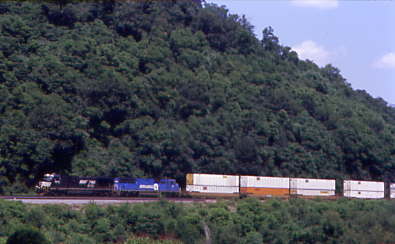
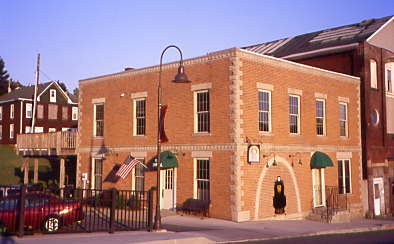
After a great visit to both the East Broad Top Railroad and Rockhill Trolley Museum, Chris Parker and I drove north on US 522 back to Mount Union then turned left on US 22 back to Altoona, where we made a beeline to Horseshoe Curve. We parked, but this time as the park was open, we had to pay and I used a coupon from the Empire State Railway Museum's Tourist Trains 2006 book for a discount. I use these discounts whenever I can to save money and the book pays for itself.
Horseshoe Curve National Historical LandmarkIn 1834, the Commonwealth of Pennsylvania built the Allegheny Portage Railroad across the Allegheny Mountains to connect Philadelphia and Pittsburgh, as part of the Main Line of Public Works. The Portage Railroad was a series of canals and inclined planes and remained in use until the mid-19th century. The Pennsylvania Railroad was incorporated in 1847 to build a railroad from Harrisburg to Pittsburgh, replacing the cumbersome Portage Railroad. Using surveys completed in 1842, the state's engineers recommended an 84-mile route west from Lewistown that followed the ridges with a maximum grade of 0.852 percent. But the Chief Engineer for the Pennsylvania Railroad, John Edgar Thomson, chose a route on lower, flatter terrain along the Juniata River and accepted a steeper grade west of Altoona. The valley west of Altoona was split into two ravines by a mountain; surveys had already found a route with an acceptable grade east from Gallitzin to the south side of the valley, and the proposed Horseshoe Curve would allow the same grade to continue to Altoona.
Work on Horseshoe Curve began in 1850 and was done without heavy equipment, only men "with picks and shovels, horses and drags". Engineers built an earth fill over the first ravine encountered while ascending, formed by Kittanning Run, cut the point of the mountain between the ravines, and filled in the second ravine, formed by Glenwhite Run. The 31.1-mile line between Altoona and Johnstown, including Horseshoe Curve, opened on February 15, 1854. The total cost was $2,495,000 or $80,225 per mile.
In 1879, the remaining part of the mountain inside the curve was levelled to allow the construction of a park and observation area—the first built for viewing trains. As demand for train travel increased, a third track was added to the curve in 1898 and a fourth was added two years later. From around the 1860's to just before World War II, passengers could ride to the PRR's Kittanning Point station near the curve. Two branch railroads connected to the main line at Horseshoe Curve in the early 20th century; the Kittanning Run Railroad and the railroad owned by the Glen White Coal and Lumber Company followed their respective creeks to nearby coal mines. The Pennsylvania Railroad delivered empty hopper cars to the Kittanning Point station which the two railroads returned loaded with coal.[20] In the early 1900s, locomotives could take on fuel and water at a coal trestle on a spur track across from the station.
A reservoir was built at the apex of the Horseshoe Curve in 1887 for Altoona; a second reservoir, below the first, was finished in 1896. A third reservoir, Lake Altoona, was completed by 1913. A macadam road to the curve was opened in 1932 allowing access for visitors, and a gift shop was built in 1940.
Horseshoe Curve is five miles west of Altoona, in Logan Township, Blair County. It sits at railroad milepost 242 on the Pittsburgh Line, which is the Norfolk Southern Railway Pittsburgh Division main line between Pittsburgh and Harrisburg. Horseshoe Curve bends around a dam and lake, the highest of three Altoona Water Authority reservoirs that supply water from the valley to the city. It spans two ravines formed by creeks: Kittanning Run, on the north side of the valley and Glenwhite Run, on the south. The Blair County Veterans Memorial Highway (SR 4008) follows the valley west from Altoona and tunnels under the curve.
Westbound trains climb a maximum grade of 1.85 percent for 12 miles from Altoona to Gallitzin. Just west of the Gallitzin Tunnels, trains pass the summit of the Allegheny Mountains, then descend for 25 miles to Johnstown on a grade of 1.1 percent or less. The overall grade of the curve was listed by the Pennsylvania Railroad as 1.45 percent; it is listed as 1.34 percent by Norfolk Southern. The curve is 2,375 feet long and about 1,300 feet across at its widest. For every 100 feet, the tracks at the Horseshoe Curve bend 9 degrees 15 arc minutes, with the entire curve totaling 220 degrees.
During World War II, the PRR carried troops and materiel for the Allied war effort and the curve was under armed guard. The military intelligence arm of Nazi Germany, the Abwehr, plotted to sabotage important industrial assets in the United States in a project code-named Operation Pastorius. In June 1942, four men were brought by submarine and landed on Long Island, planning to destroy such sites as the curve, Hell Gate Bridge, Alcoa aluminum factories and locks on the Ohio River. The would-be saboteurs were quickly apprehended by the Federal Bureau of Investigation after one, George John Dasch, turned himself in. All but Dasch and one other would-be saboteur were executed as spies and saboteurs.
Train count peaked in the 1940;s with over fifty passenger trains per day, along with many freight and military trains. Demand for train travel dropped greatly after World War II, as highway and air travel became popular. During the 1954 celebration of the centennial of the opening of Horseshoe Curve, a night photo was arranged by Sylvania Electric Products using 6,000 flashbulbs and 31 miles of wiring to illuminate the area. The event also commemorated the 75th anniversary of the incandescent light bulb.
Pennsylvania steam locomotive 1361 was placed at the park inside the Horseshoe Curve on June 8, 1957. It is one of 425 K4s-class engines: the principal passenger locomotives on the Pennsylvania Railroad that regularly plied the curve. The Horseshoe Curve was listed on the National Register of Historic Places and was designated a National Historic Landmark on November 13, 1966. The operation of the observation park was transferred to the city of Altoona the same year. The Pennsylvania Railroad was combined with the New York Central Railroad in 1968, creating Penn Central, which went bankrupt in 1970 and was taken over by the federal government in 1976, as part of the merger that created Conrail.
The second track from the inside at the Horseshoe Curve was removed by Conrail in 1981. The K4 1361 was removed from the curve for a restoration to working order in September 1985 and was replaced with the ex-Conrail EMD GP9 diesel- electric locomotive 7048 that was repainted into a Pennsylvania Railroad scheme. Starting in June 1990, the park at the Horseshoe Curve underwent a $5.8 million renovation funded by the Pennsylvania Department of Transportation and by the National Park Service through its "America's Industrial Heritage Project". The renovations were completed in April 1992 with the dedication of a new visitor center.
In 1999, Conrail was divided between CSX Transportation and Norfolk Southern, with the Horseshoe Curve being acquired by the latter. The Horseshoe Curve was lit up again with fireworks and rail-borne searchlights during its sesquicentennial in 2004 in homage to the 1954 celebrations and was designated a National Historic Civil Engineering Landmark by the American Society of Civil Engineers in 2004.

A schematic of the curve.
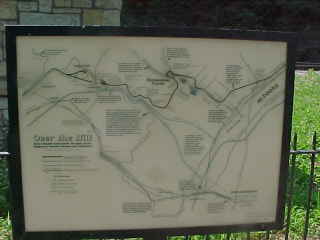
With the funicular running only so often, we took the stairs to the viewing area and the lighting was much better than yesterday.
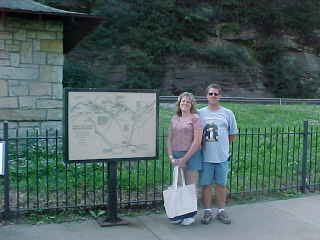
I found a table under a tree and met Karen and Jim Walter, who were also visiting.


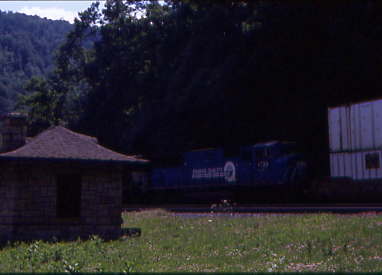
At 3:15 PM, a westbound train with Norfolk Southern and former Conrail locomotives came by.
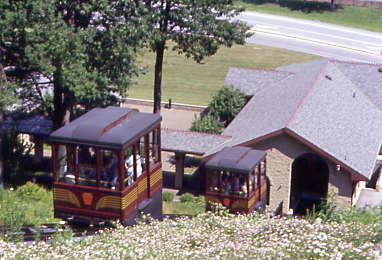
The Horseshoe Curve funicular, a 288 foot railway that provides visitors an easy way to access the observation platform. It is single-tracked, with the cars passing each other halfway up the slope; the cars are painted to resemble Pennsylvania Railroad passenger cars. The schedule is every half hour from 10:30 am until 6:00 pm. The cars have a 12 passenger limit and additional runs will be made immediately following the current load.
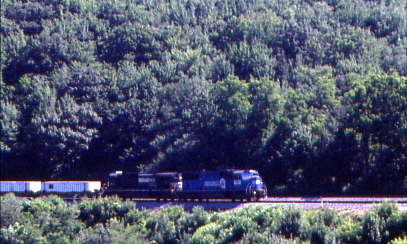
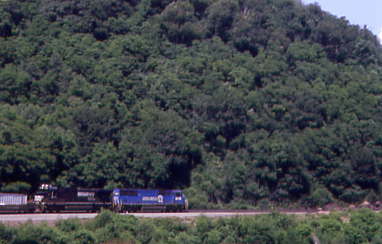
At 3:41 PM, an eastbound train with former Conrail and Norfolk Southern locomotives, passed.

Seven minutes later was another westbound with Norfolk Southern and BNSF motive power.
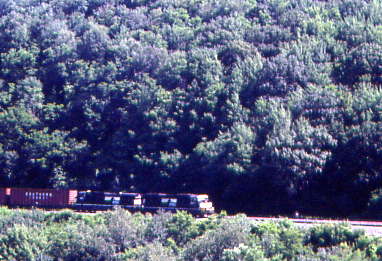
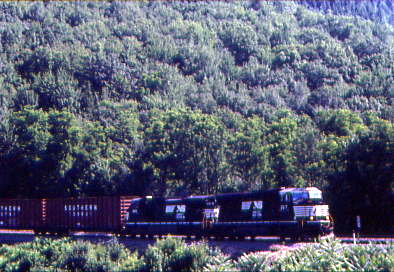
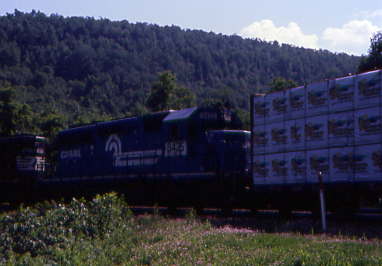
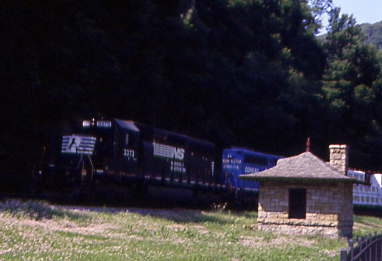
At 4:08 PM, we saw a second eastbound train with a pair of Norfolk Southern engines, a former Conrail engine and Norfolk Southern helpers.
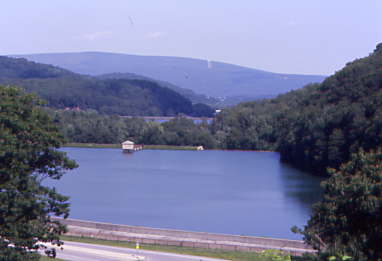
Altoona Reservoir, as seen between trains.
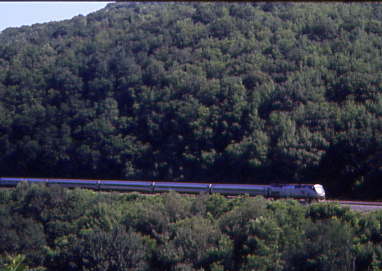
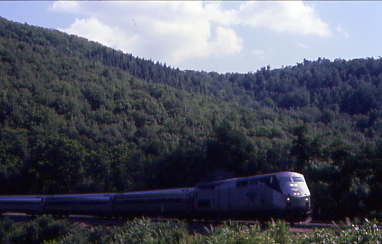
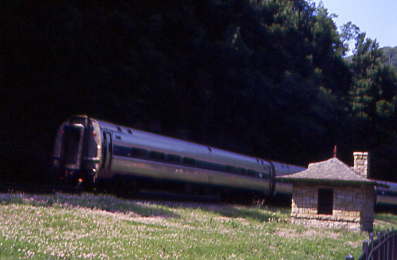
Amtrak 44, the eastbound Pennsylvanian, rounded Horseshoe Curve at 4:10 PM, about twenty minutes late.
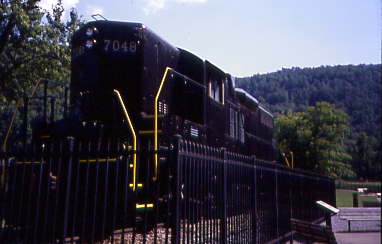
Conrail GP 7048, ex. Penn Central 7048, nee Pennsylvania Railroad GP9 7048 built by Electro-Motive Division in 1955, on display. It was placed here in 1985 and restored to its original Pennsylvania Railroad paint scheme.
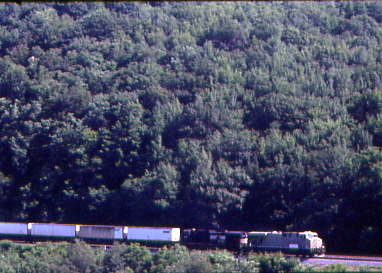
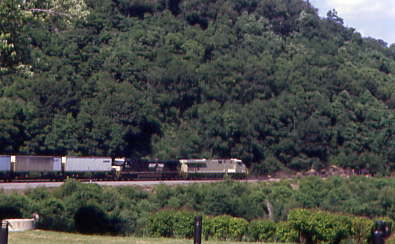
At 4:31 PM, another eastbound Norfolk Southern train with one locomotive in primer.
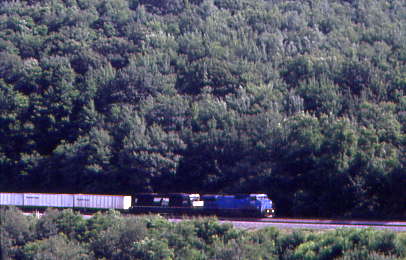
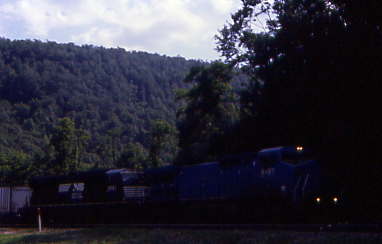
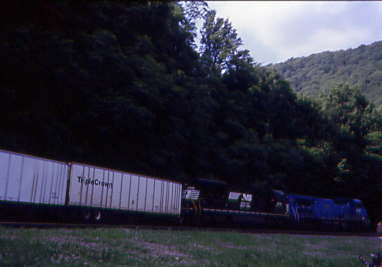

At 4:45 PM was yet another eastbound, led by former Conrail and Norfolk Southern locomotives units pulling Triple Crown Roadrailers.
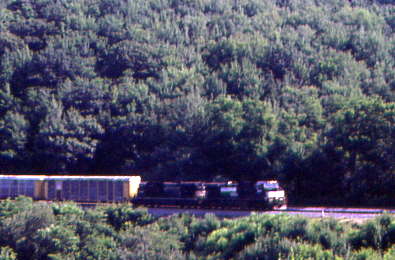
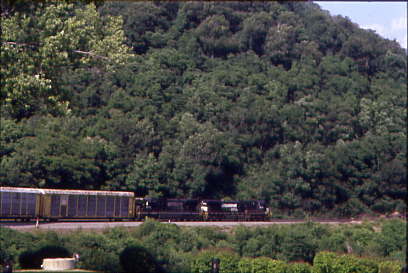
A fourth eastbound train came through at 4:53 PM with two Norfolk Southern units.
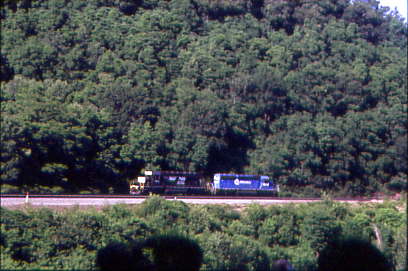
Then at 5:30 PM, the helpers returned west around the Curve.
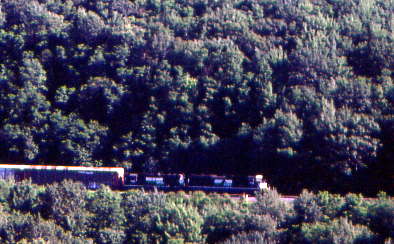
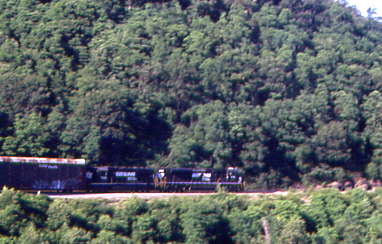
At 6:11 PM, another eastbound with two Norfolk Southern locomotives pulling auto racks.
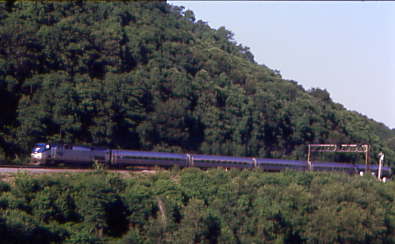
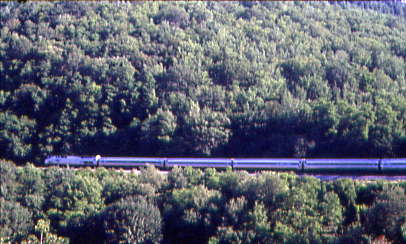
Our final train was Amtrak 43, the westbound Sunday Pennsylvanian, at 6:22 PM, about two hours late. After that, Chris and I packed up before walking downstairs and turned right from the parking lot and passed beneath the railroad through a tunnel. We travelled about two-and-a-half miles to a "T" junction and turned left towards Gallitzin, then when we saw the big blue "Library" sign, turned right.
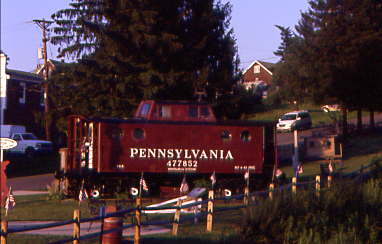
We went down the hill, turned left and parked at the Tunnel Park Caboose & Museum where Pennsylvania Railroad caboose 477859 built by the railroad in 1942 is on display. Across the tracks, I saw the Tunnel Inn.
The Tunnel InnThe Tunnel Inn offers four suites, three with a trackside view. We are located at Milepost 248.0 on Norfolk Southern's Pittsburgh Line at the summit of the Allegheny Mountains in Gallitzin, Pennsylvania. Gallitzin is also home to the Gallitzin Tunnels - both the Alleghany Tunnel & New Portage Tunnel. These tunnels were built between 1851 and 1854 the allegheny tunnel is 3,612 feet long and pierces the mountain at 2,167 feet above sea level. The sights and sounds of trains at Run 8 - full throttle - battling the allegheny mountains grades are easily enjoyed from our covered back porch. Our chiminea (outdoor stove) takes the chill out of the cool mountain night air while our LED floodlights illuminate the track area to provide ample night time railfanning. The Tunnel Inn is located at the mouth of the Allegheny Tunnel on Tracks 2 & 3, Track 1 runs on the opposite side of town - about a ten minute walk from the inn. We offer all guests continental breakfast in the morning, private bathrooms with a walk-in shower, Cable television, wall-Mounted AC Units in all rooms and Wi-Fi.

We drove over the bridge across the tracks, pulled into the Tunnel Inn and Chris stayed in the car while I went to check in.
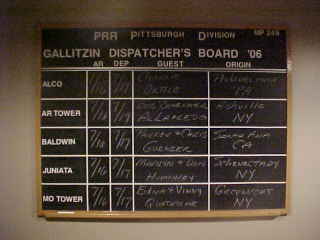
I walked in and saw a board which listed all of the Tunnel Inn's guests and where they came from. I found the innkeeper and she showed me that our keys were on the board by our name then went with her to check in and we received the Baldwin Suite for this night.
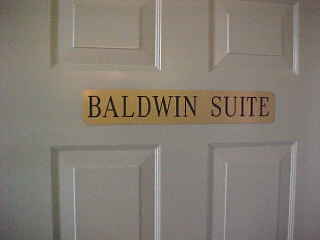
The door to the Baldwin Suite.
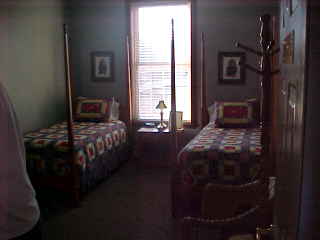
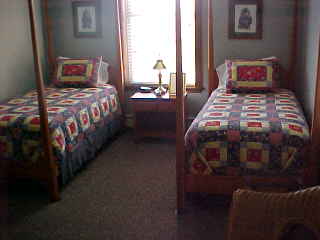
Our room, which had twin beds and two windows, one overlooking the tracks and the other overlooking the deck.
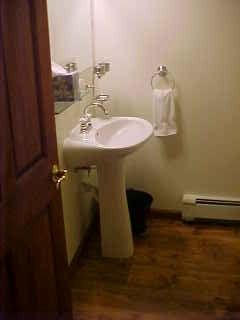
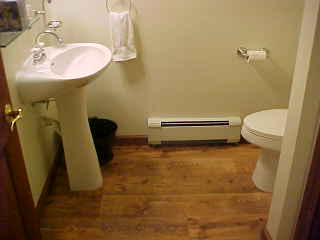
The Baldwin Suite's bathroom. We unloaded the car and Chris was as impressed with the room as I. Both hungry, we walked down the street to the Iron Horse Café for dinner then upon our return, put in our breakfast order before I went out on the bridge for some Norfolk Southern rail action.
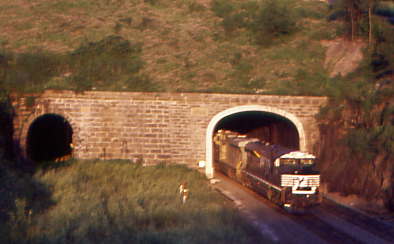
A westbound Norfolk Southern train came out of the Gallitzin Tunnels.
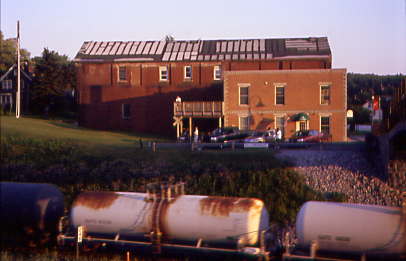
I spotted our room at the Tunnel Inn on the second floor at the left end.
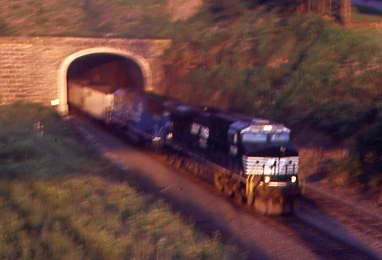
Another westbound Norfolk Southern train exited the tunnel.
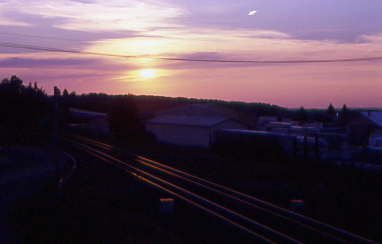
Since it was getting near sunset, I could not resist taking a photograph of a very good-looking western sky. Later, I was sitting on the deck chatting with some of the guests when we heard something climbing the grade. If a train comes on tracks 2 or 3, it passes the Tunnel Inn but track 1 is about six blocks west. An eastbound train came by then stopped under the bridge for a few minutes before going into the tunnel. After having such a great day at the East Broad Top Railroad, Rockhill Trolley Museum, Horseshoe Curve and here, I was one tired Chris so showered and called it a night.
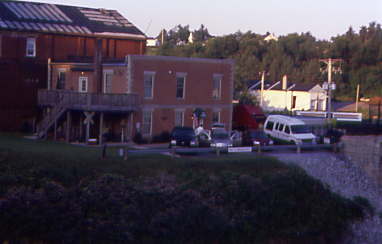
7/17/2006 After sleeping in, I opened the door to find our breakfast in a picnic basket and we took it out on the deck and set up breakfast on a table. We enjoyed our hot beverages, Chris coffee and me tea, muffins and orange juice. After breakfast I walked over to Caboose Park for another picture of the inn before returning to pack, then checked us out and waited for Chris to come down.
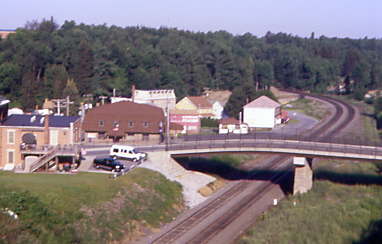
We drove over to the top of the hill for a last picture of the hotel. I would stay here again in an instant as it is a great Bed and Breakfast with a fantastic railfan location. Chris and I drove away en route to New Philadelphia, Ohio for the National Railway Historical Society convention, with a stop at the Pennsylvania Trolley Museum in Washington, Pennsylvania.
| RETURN TO THE MAIN PAGE |